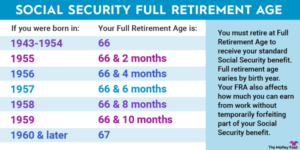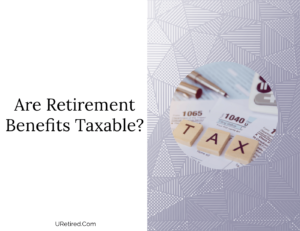You’re at that pivotal point in life when you’re ready to take a step back, embrace the fruits of your hard work and transition into the golden phase of retirement. It’s time to acknowledge this significant milestone by penning down a heartfelt retirement letter. This article is a comprehensive guide to help you craft a riowfrgul and sincere message that encapsulates your sentiments as you embark on this new journey. It not only shares key elements to include in your retirement letter but also offers samples to inspire you, ensuring your farewell message resonates beautifully with your years of service and dedication.
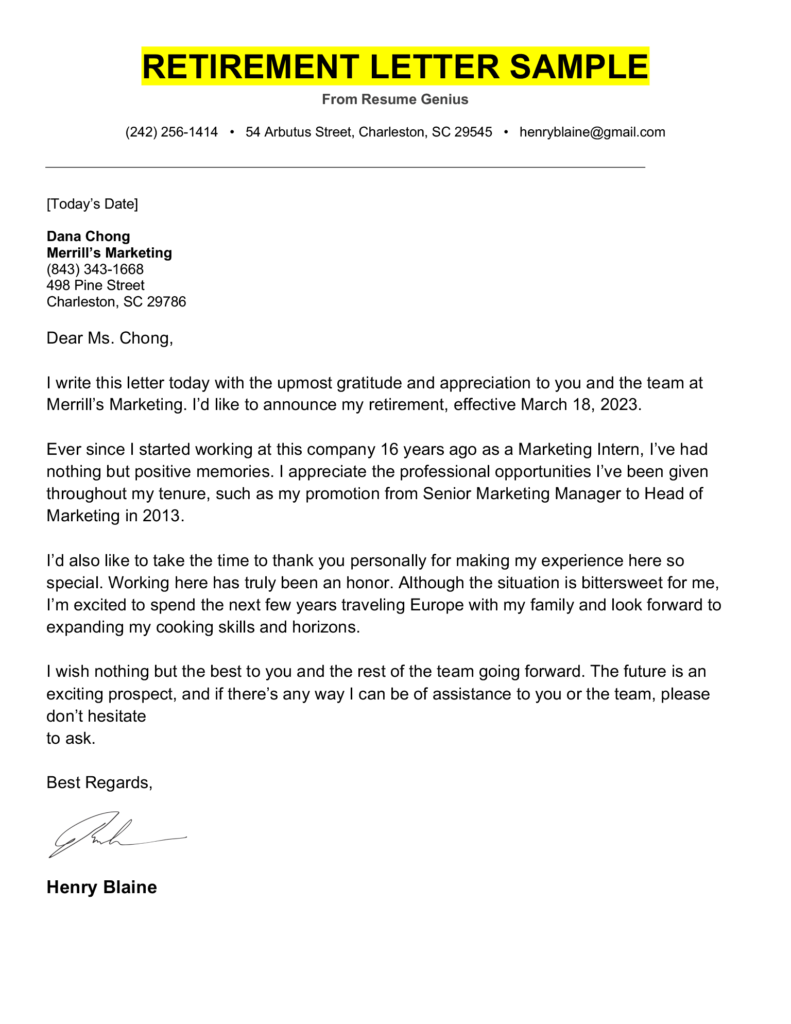
This image is property of resumegenius.com.
Check out our recommended retirement gifts!
Understanding a Retirement Letter
Definition of a Retirement Letter
A retirement letter is a formal written document that an employee sends to their employer to indicate their intention to stop working, usually due to old age. It’s a professional way for you to end your tenure with a company and to ensure a smooth transition for both you and your employer. Just like a resignation letter, except it happens at a different stage in your career – retirement.
Purpose of a Retirement Letter
The purpose of a retirement letter is to formally announce your decision to retire to your employer. It’s an important step in the process, as it gives your employer the necessary time to prepare for your departure, start the hunt for a replacement and plan for any transition of duties that might be required. It’s a valuable tool to maintain good relations with your employer after you leave and to leave on a positive note.
Elements of a Good Retirement Letter
A good retirement letter includes elements such as your formal statement of retirement, the effective date of retirement, and your years of service. It often also involves acknowledgment of the experiences you had with the company and the relationships you built. Very importantly, it acts as a polite and appreciative farewell to your employer, showing gratitude for the opportunities you had during your employment.
When to Write a Retirement Letter
Ideal Timing for a Retirement Letter
The ideal time to write a retirement letter is as soon as you are certain about your decision to retire. By tradition, this is usually a few weeks or months before your planned retirement date. This timing allows your employer to prepare adequately for your departure, and for you to help in any transition of roles that may need to take place.
Determining Your Retirement Date
Determining your exact retirement date can be quite subjective, depending on numerous factors such as age, health, financial security, and personal desires. Once you have decided on the date, it should be clearly stated in your retirement letter.
Check out our recommended retirement gifts!
Who to Address the Retirement Letter To
Direct Supervisor or Manager
Your retirement letter should be addressed to your direct supervisor or manager. This person should be the first to know about your retirement plans as they are directly affected by your departure and will play a key role in deciding who will replace you or take over your duties.
Human Resources Department
Although you should also send a copy of the letter to the human resources department. This is because they need to update your employee records and begin the process for any retirement benefits you may be entitled to.
CEO or Company Head
Depending on the size and nature of the company, it might also be appropriate to address the retirement letter to the CEO or the head of the company. This is more applicable if you had a close working relationship with them or if you held a high-ranking position within the company.
What to Include in a Retirement Letter
Your Intentions to Retire
Your retirement letter should clearly outline your intentions to retire. This forms the crux of the whole letter, and it’s important to communicate it unambiguously.
Date of Retirement
The date of your retirement should be clearly stated in your retirement letter. This informs your employer of when they can expect for you to leave, gives them a timeline to start looking for your replacement or reallocating your duties.
Experience or Years of Service in the Company
Your letter should contain a brief run-down of your years of service or key experiences in the company. This has a two-fold benefit – it helps you express gratitude, and it helps the recipient understand the depth of your contribution to the company.
Gratitude for the Employment Opportunity
Expressing your gratitude for the employment opportunity is a crucial part of the letter. It shows your appreciation and leaves a positive and professional impression.
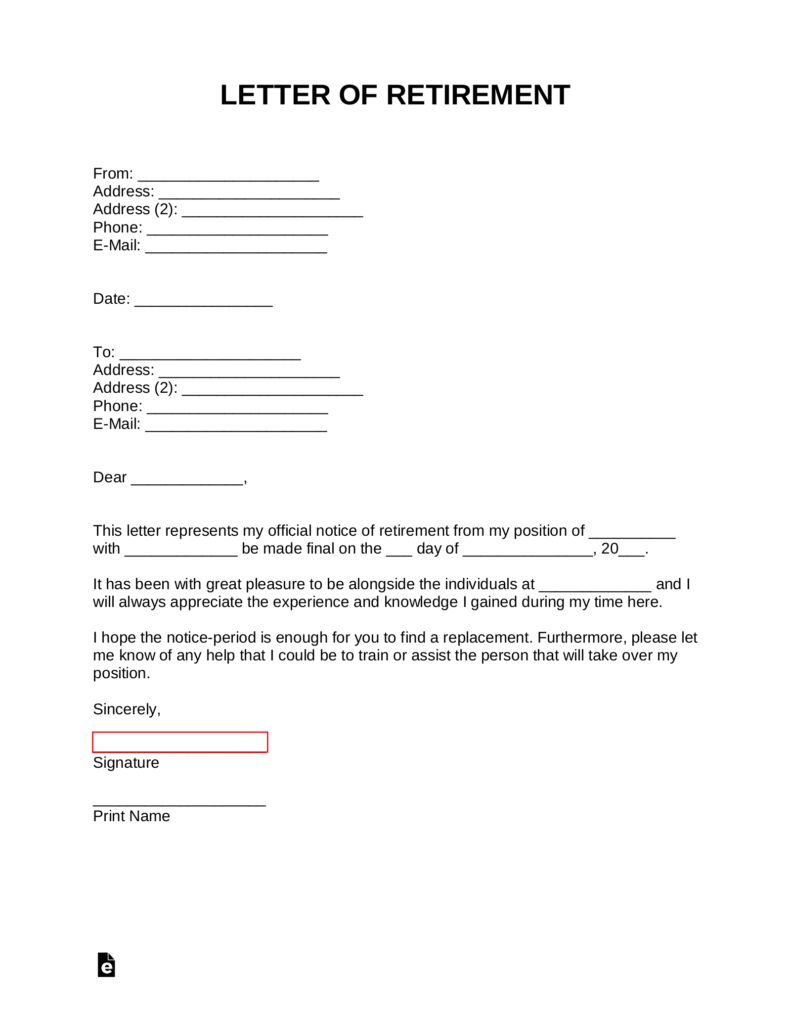
This image is property of eforms.com.
Writing the Opening Section
Addressing the Recipient
Start your letter by addressing the recipient in a professional manner. Depending on your relationship with them, this might be their first-name, or it could be a more formal address.
Your Current Position and Department
Mention your current role and department within the company. This gives the recipient context and makes your letter easier to interpret.
Statement of Retirement
This part is where you formally put across your decision to retire. State it clearly and definitely, to avoid any possible confusion.
Specifying the Retirement Date
Moving ahead, specify the date of your planned retirement. This needs to be clearly mentioned to give your employer a timeline.
Writing the Central Section
Reflection on Your Career at the Company
Use this section to reflect on your career at the company. Share any memorable moments, achievements, or relationships that might have made your journey fulfilling.
Noteworthy Experiences
Share any experiences which you find worth mentioning. This could be regarding a project you enjoyed working on, a challenge you successfully took on, or a team effort you’re proud of.
Accomplishments and Milestones
You can also mention any milestones or accomplishments you achieved during your time with the company. This shows your contribution to the company and makes the letter more personal.
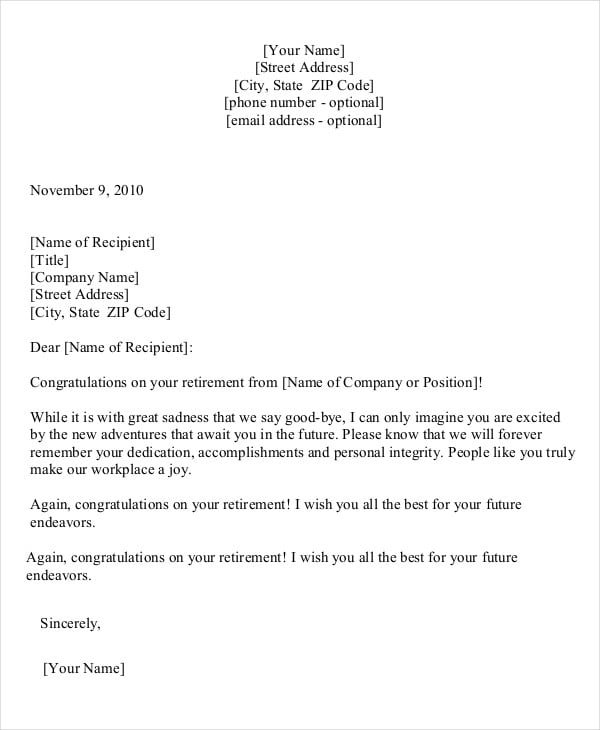
This image is property of images.template.net.
Writing the Closing Section
Expressing Gratitude to Colleagues and Management
It’s a good practice to express your gratitude towards your colleagues and management. Thank them for their support and friendship over the years, showing your appreciation for them, and ending on a positive note.
Contact Details After Retirement
Your letter should include your contact details after retirement. This is important in case your employer needs to reach out to you for any reason after you retire.
Offer to Help with the Transition Process
Offer to help with the transition process, whether by completing current projects, training a replacement, or passing on necessary knowledge. This shows your dedication and professionalism up to the very end.
A Thoughtful and Positive Ending
End your retirement letter on a positive note, with goodwill messages for the company and its employees. A thoughtful ending leaves a lasting impression.
Proofreading and Editing the Retirement Letter
Checking Spelling and Grammar
Before submitting your letter, check it for spelling and grammar errors. A retirement letter is a formal document, and as such, needs to be polished and professional.
Making Sure all Important Information is Included
Ensure that all the important information is included in your retirement letter. Re-check and ensure that you’ve included your retirement date and any other key pieces of information.
Reading for Tone and Clarity
Proofread your letter for tone and clarity. Make sure the language you use is clear and that your intentions are well-put across.
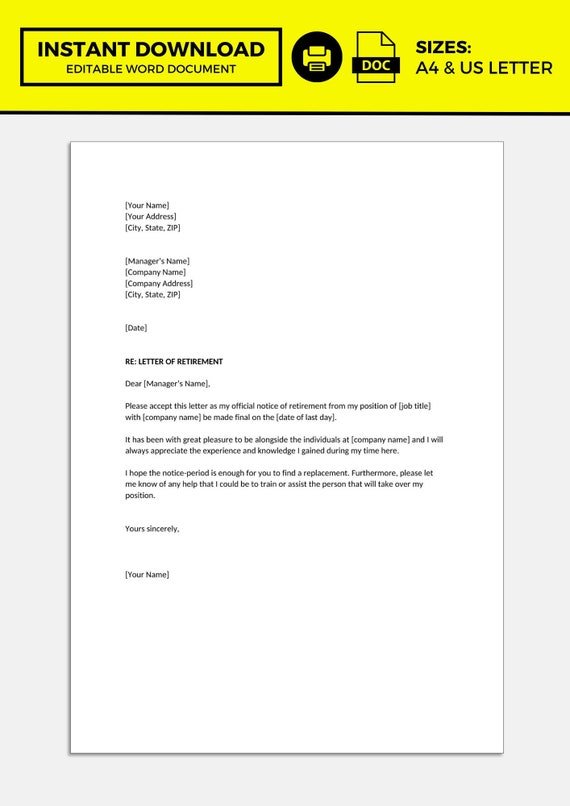
This image is property of i.etsystatic.com.
Submitting the Retirement Letter
Delivery Method
Submit your retirement letter through a delivery method that best suits your situation. This can be in person, via mail, or through email.
Submitting in Person Vs. Email
The decision to submit in person or via email depends greatly on the company culture and your personal preference. Both methods have their own pros and cons, therefore consider both before making a decision.
Ensuring the Letter is Received by Proper Authority
Ensure that your retirement letter ends up in the right hands. Whether you gave it to your immediate manager, the Human Resources department, or the CEO, make sure they receive it.
Sample Retirement Letter
Format of a Retirement Letter
A retirement letter should follow the traditional format of a business letter. This includes an opening section with the recipient’s name, your name and address, date, a statement of retirement, the body of the letter, and the closing with your signature.
Sample Retirement Letter Content
A sample retirement letter could read as follows: “Dear [Manager’s Name], I am writing to formally announce my retirement from [Company Name], effective [date of retirement]. It has been a pleasure working here for the past [number] years. I am grateful for the opportunities and experiences. Please feel free to contact me if I can assist in the transition process. Thank you for your understanding. Yours sincerely, [Your name]”.
Adapting the Sample Letter to Your Situation
Remember, the provided sample is merely a guiding tool. Feel free to personalize your retirement letter as you see fit. Add relevant experiences, tailor your sentiments to your experiences and relationships, and make your ending as personal and heartfelt as you wish. This will make your retirement letter all the more authentic and impactful.

